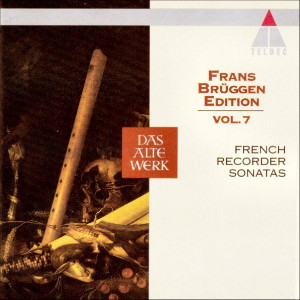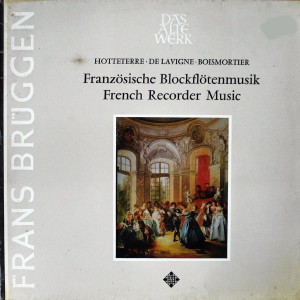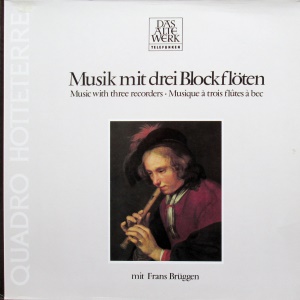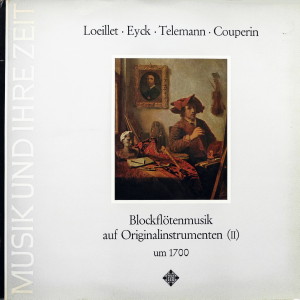 |
|
1 CD -
4509-97469-2 - (c) 1995
|

|
| 1 LP -
SAWT 9570-B - (p) 1970 |
 |
| 1 LP -
6.42365 AW - (p) 1979 |
 |
| 1 LP -
SAWT 9545-A - (p) 1969 |
|
| FRANS
BRÜGGEN EDITION - Volume 7 |
|
|
|
|
|
| FRENCH RECORDER SONATAS |
|
|
|
|
|
| Philibert de Lavigne
(c. 1700-1750) |
|
|
| Sonata
in C major "La Barssan" -
descant recorder and basso continuo
- from "Sonates pour la Musette,
Vièle, ..." |
6' 51" |
|
| 1.
Gracieusement |
2'
09" |
|
2.
Rondeau, Pas trop vite
|
2' 31" |
|
| 3.
Tambourin |
2' 11" |
|
|
|
|
| Joseph Bodin de
Boismortier (1689-1755) |
|
|
| Sonata
in F minor (D minor) - three
treble recorders - from "Sonates
en Trio, pour trois Flûtes
Traversières sans Basse op. 7",
Paris 1725 |
15' 00" |
|
| 4.
Doucement |
4' 17" |
|
| 5.
Courante |
2' 17" |
|
6.
Allemande
|
4' 42" |
|
| 7.
Menuet |
3' 44" |
|
|
|
|
| Anne Danican Philidor
(1681-1728) |
|
|
| Sonata
in D minor - treble recorder
and basso continuo |
8' 51" |
|
| 8. Lentement |
2' 36" |
|
| 9. Fugue |
1' 17" |
|
| 10. Courante |
1' 39" |
|
| 11. Gracieusement
|
1' 43" |
|
| 12. Fugue |
1' 36" |
|
|
|
|
| Louis-Antoine Dornel
(c.1680 - soon after 1756) |
|
|
| Sonata
[a 3 Dessus] in B flat major -
three treble recorders |
5' 43" |
|
| 13. [?] |
1' 10" |
|
14. Fugue, Gayment
|
1' 21" |
|
| 15. Lentement |
1' 47" |
|
| 16. Vivement |
1' 25" |
|
|
|
|
| François Couperin le
grand (1668-1733) |
|
|
| 17. Le
rossignol-en-amour -
sopranino in f" and harpsichord -
from "Pièces de clavecin,
Vol. III (Quatorzième Ordre),
Paris 1722 |
7' 25" |
|
|
|
|
| Frans Brüggen, recorder |
The instruments
|
|
| Anner Bylsma, violoncello
(1-3, 8-12) |
recorders: |
|
| Gustav Leonhardt,
harpsichord (1-3, 8-12, 17) |
- Martin
Skowroneck (after Terton), Bremen
descant [soprano]
in c" - [1-3] |
|
| Kees Boeke, recorder
(4-7, 13-16) |
- Friedrich von
Huene (after Denner), Boston treble
[alto] in f'
- [4-7] |
|
| Walter van
Hauwe, recorder
(4-7, 13-16) |
- Hans Coolsma
(after Bressan), Utrecht treble
in f' - [4-7] |
|
|
- Friedrich
von Huene (after
Denner), Boston treble in f' -
[8-12] |
|
|
- Frederick
Morgan (after Bizey), Melbourne
1976 treble
in f' - [13-16] |
|
|
- Jakob
Denner, Nuremberg c. 1700
sopranino in f" -
[17] |
|
|
|
|
|
Luogo
e data di registrazione |
|
- Palais
Schwarzenberg, Vienna
(Austria) - novembre 1965
[1-7]
- Bennebroek
(Olanda) - febbraio 1970 [8-14]
- Doopsgezinde Kerk, Amsterdam
(Olanda) - gennaio & novembre
1971 [16-21]
|
|
|
Registrazione:
live / studio |
|
studio |
|
|
Producer /
Engineer |
|
Wolf
Erichson [8-12] - Heinrich Weritz
[13-16]
|
|
|
Prima Edizione
LP |
|
- Telefunken
"Das Alte Werk" - SAWT 9482-A -
(1 LP) - durata 48' 01" - (p)
1966 - Analogico [1-7]
- Telefunken "Das Alte Werk" -
SAWT 9570-B - (1 LP) - durata
45' 46" - (p) 1970 - Analogico
[8-14]
-
Telefunken "Das Alte
Werk" - SAWT 9582-A - (1
LP) - durata 52' 43" -
(p) 1972 - Analogico
[15-21]
|
|
|
Edizione CD |
|
Teldec
- 4509-97469-2 - (1 CD) - durata
44' 46" - (c) 1995 - ADD |
|
|
Note |
|
- |
|
|
|
|
Virtually
nothing is known about the
life of Philibert de
Lavigne. His set of six
Sonatas op. 2, from which
the present work is taken,
was published around l740.
Their title-page mentions
not only the recorder but
also the musette (a small
bag-pipe) and vielle
(hurdy-gurdy), both of which
were then fashionable among
the Paris aristocracy, who
thought of them
nostalgically as the
indispensable concomitants
of pastoral music and bergeries.
The descant recorder used in
the present recording proves
superior to the treble
recorder demanded by the
composer, not least in the
vigour and verve that it
lends to the final movement,
which is described as a
Tambourin.
Joseph Bodin de Boismortier
was a deft and prolific
composer who cornered the
market in Paris and almost
literally flooded it with
his simple, unpretentious
music. That he was capable
of writing more demanding
works is clear, however,
from the present sonata for
three flutes, recorded here
in a transcription for three
treble recorders. (In
keeping with a suggestion by
Boismortiers contemporary
Hotteterre, the work has
been transposed up a minor
third. A similar
transposition will be also
found in the case of
Dornel's sonata, which is
likewise included in the
present recording.)
Anne Danican Philidor hailed
from a large family of
musicians well known in 17th-
and 18th- century France.
The name "Philidor"
is said to have been given
to Michel Danican (who may
have been the brother of
Annes grandfather) by Louis
XIII
in memory of the Sienese
oboist Filidori, a
particular favourite of the
kings. The present sonata is
one of the few original
French works for the
recorder. Stylisticallyg,
too, it stands apart from
Philidor’s other works, the
majority of which are cast
in the form of a suite, its
stricter compositional style
suggesting, rather an
affinity with the sonata
da chiesa. The second
and fifth movements are
fugal in character while the
fourth is notable for its
use of invertible
counterpoint, with the upper
voice and bass line
interchanged.
Little is known about
Louis-Antoine Dornel. In
1706 he was appointed
organist at Ste
Madeleine-en-la-Cité in
Paris, a post for which no
less a composer than Jean-Philippe
Rameau had been a fellow
contestant. In 1725 he
became maître
de musique to the
Académie Française.
Like Philidor’s Sonata, his
B flat major Sonata (first
published in 1723) is
preponderantly fugal in
texture, with the lowest
voice joining in the
contrapuntal writing in
spite of its function as a
bass line supporting the
harmonies above it.
François
Couperin's Le
rossignol-en-amour is
a character piece notable
for its poetic tone-painting,
with the nightingale's
singing depicted by numerous
ornaments, some of which are
described as accents
plaintifs.
Although originally written
for the harpsichord,
Couperin himself suggested
entrusting the upper voice
to a flute, a practice that
would “ensure a greater
effect, provided only that
it is well
played”. Frans Brüggen's
decision to use a sopranino
recorder, with its silvery
higher register further adds
to the charm of the work.
Martin Nitz
·····
A brief
history of the
recorder
7.
The recorder in the 18th
century
National
styles: Germany
(II)
Second only to the
Denners as Nuremberg’s
leading family of
18th-century
woodwind-instrument
makers were the
Oberlenders, with almost
60 instruments surviving
from the workshop of
Johann Wilhelm
Oberlender (1681-1763)
and his son, also called
Johann Wilhelm
(1712-1779). The
majority of these
instruments are soprano
recorders, but their
number also includes
sopranino, tenor and
bass recorders, as well
as flutes, a single flûte
d'amour,
oboes and several
clarinets. Like Denner's
instruments, they are
distinguished by the
clarity of their tone,
especially in the higher
register a clarity due
to their relatively
narrow bore. Preferred
materials are boxwood,
maple, plum and ivory.
Many of the Oberlenders’
instruments are
elaborately carved.
The woodwind-instrument
maker Johann Heinrich
Eichentopf (c.
1686-1769)
was active in Leipzig at
the time of Johann
Sebastian Bach. In 1710,
on the occasion of his
marriage in the city's
Thomaskirche (where Bach
was to be appointed
Cantor in 1723),
he was described as a "maker
of instrumental pipes".
Only two of Eichentopf’s
recorders have survived,
a soprano and a tenor
instrument, both in
boxwood and clearly German
in their construction,
with a narrow bore and
correspondingly
bright-toned upper
register. They may be
heard in Vol. 12, tracks
1-4.
A
glance
at the German
Baroque repertory
for recorder shows
that it is generally
the higher register
that is preferred,
with its very
highest reaches
being explored by
Bach in his later
cantatas and by
Telemann in his
sonatas and
concertos. This does
not present any
great difficulties
on instruments by
Denner, Eichentopf
and Oberlender. It
is not unlikely that
Nuremberg recorders
found their way
to Venice in the
18th century and
that they encouraged
Vivaldi to write his
brilliantly
virtuosic recorder works,
with their
exploitation of the
instrument's highest
register. At all
events, the Red
Priest’s recorder concertos
are particularly
effective when
played on
instruments by
Denner or on ones
related to them.
Peter
Holtslag
Translation:
Stewart Spencer
|
|